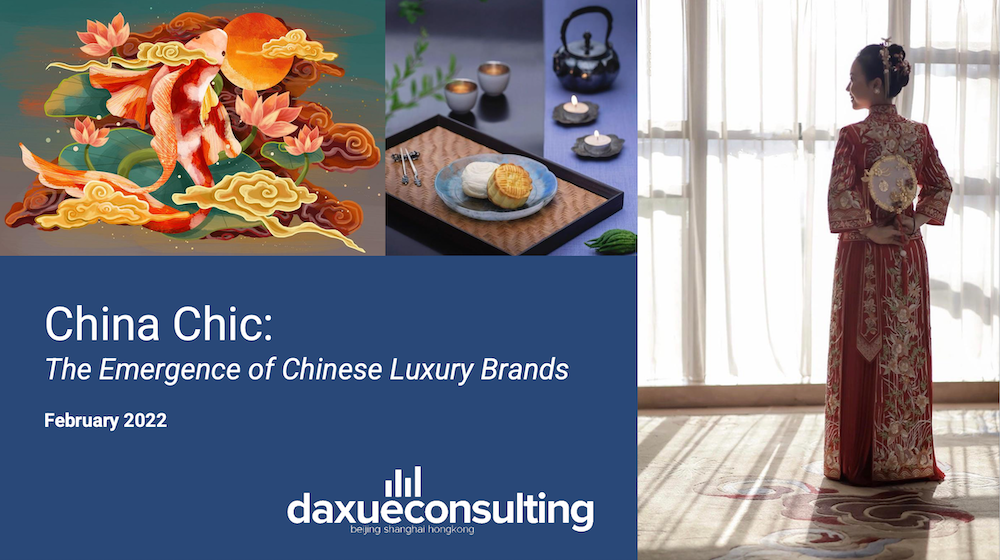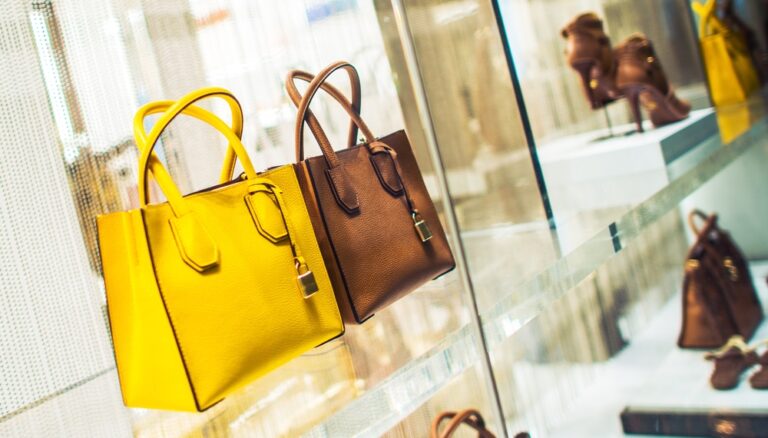Nowadays Chinese consumers are a major driver of growth for the global luxury industry and their importance is bound to increase in the years to come. Indeed, mainland China is expected to become the world’s largest luxury goods market by 2025, thereby surpassing the regional share of the Americas and Europe. Covid-19 travel restrictions induced Chinese consumers to purchase luxury items domestically, thus stimulating the demand for duty-free goods.
Meanwhile, the wave of growing nationalism and cultural confidence, along with a shift in the perception of the Made in China label, are creating a conducive ground for the rise of Chinese luxury brands. That is why we surveyed 1,000 Chinese consumers to know more about their thoughts around Chinese luxury brands and we investigated 5 hypotheses on the emergence of local luxury players.
Download our full report on The Emergence of Chinese Luxury Brands
An evolving definition of luxury in China
When the country opened up and luxury goods began to circulate again in China, the first generation of Chinese luxury consumers utilized luxury goods to flaunt their wealth and show other people that they managed to climb the social ladder. Nevertheless, as society changes and per capita income grows, a new definition of luxury emerges in China.
Nowadays, luxury goods in China are meant as a way to reward and express oneself in a more elevated way, and this is especially true for young Chinese consumers. As luxury converts into a method of self-actualization and self-expression, the key elements of China’s new concept of luxury become experience, innovation, customization, and cultural sensitivity. Indeed, young Chinese consumers do not just want to pamper themselves through enjoying a luxury experience, but they are also eager to share it on social media and build up a community of kindred spirits. Thus, it is not surprising that customization services shifted from being a nice-to-have option to becoming a must-have feature, allowing Millennial and Gen Z consumers to express their cultural identity.
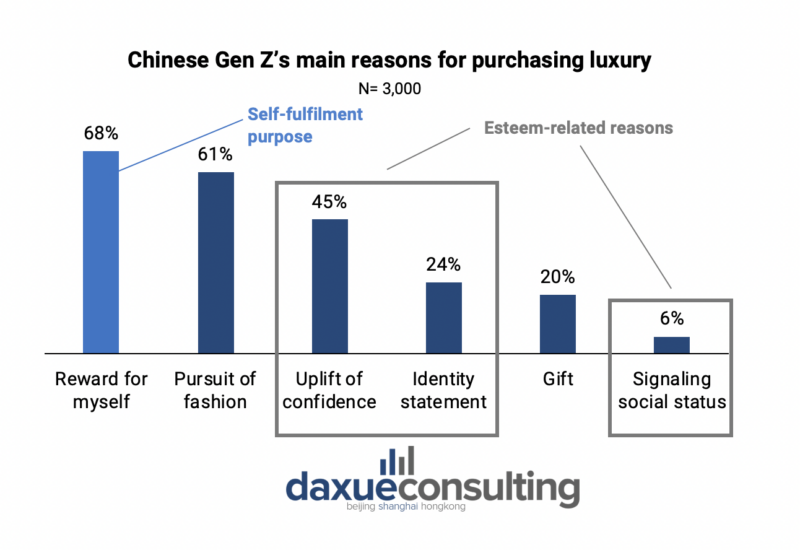
Made in China: from copycat to innovation
Before the so-called “Century of Humiliation”, China was considered a luxury superpower: the Middle Kingdom used to be the country of origin of the finest manufactured goods and European elites competed to flaunt the most beautiful and original ones. Nonetheless, after decades marked by semi-colonialism, civil wars, invasions, and revolutions, China’s industrial capital got eroded. Following the launch of the economic reforms, China quickly became the “factory of the world”, hence, “Made in China” turned into a synonym for copy-cat and low-quality.
However, as the country gradually moves up the value chain, Chinese consumers have started changing their perceptions of local goods, associating them more and more often with “innovation” and “high-quality”. Such phenomenon reflects a certain degree on the luxury industry as well: our surveyees mentioned China as the country whose luxury goods attract them the most and about 64% of them claimed having previously purchased Chinese luxury products. Branding is still a deciding factor as many Chinese luxury shoppers are first-time consumers and prefer purchasing well-established international luxury brands. However, it does not mean that such buying behavior will persist once homegrown luxury brands acquire the same authority and prestige.
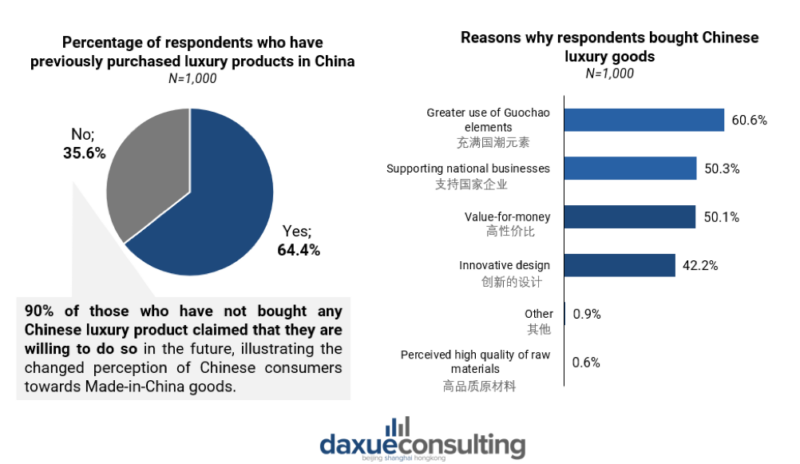
The Guochao wave is accelerating the rise of Chinese luxury brands
Guochao (国潮), literally “national trend,” refers to the increased consumer favoritism towards Chinese brands, designs, and culture. Stemming from a growing sentiment of nationalism and cultural confidence in consumption, Guochao played a major role in changing Chinese consumers’ perception of local brands.
The luxury industry was not left untouched by Chinese consumers’ desire to eliminate the patina of Western orientalism, which has for long filtered the way Chinese style was projected in the fashion industry. According to our results, Guochao includes both functional and emotional features: Chinese consumers do not purchase Chinese luxury goods solely due to the greater presence of Chinese cultural elements and for supporting national businesses, but also because Chinese brands are automatically associated with a higher value-for-money, more attentive customer care, and a greater variety of customized services. Such functional elements are especially important to Gen Z consumers, who tend to be more convenience and service-oriented than the overall consumer base is.
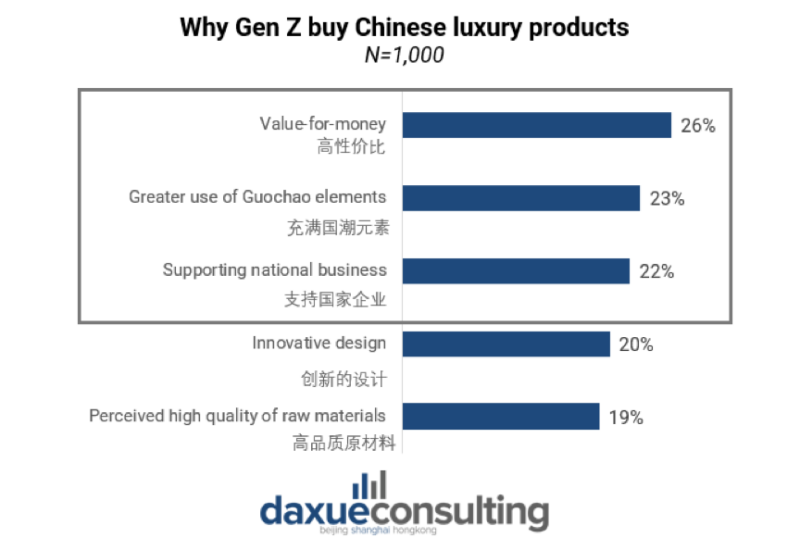
Hypotheses for the emergence of Chinese luxury brands
Although the Guochao wave, along with the shift in the perception of Made-in-China products, have undoubtedly changed Chinese consumers’ attitude towards local goods, do the preconditions for the rise of Chinese luxury brands exist? Daxue Consulting investigated five hypotheses on the emergence of local luxury brands.
1. Domestic luxury brands rooted in Chinese traditions and customs will rise
Several luxury market segments in China are currently dominated by foreign firms, therefore, by focusing on products deeply rooted in Chinese tradition, Chinese brands could bypass competition with big international luxury names and compensate for their lack of history by creating a connection with China’s millennium-old culture.
2. Chinese luxury brands will leverage traditional Chinese medicine (TCM) in cosmetics and fragrances
Growing health awareness is boosting Chinese consumers’ demand for natural ingredients in beauty products. TCM-based cosmetics and fragrances are beloved by Chinese young shoppers since they are considered green, safe, and especially suitable for sensitive skins. Currently, there are very few luxury brands specialized in such fields, unveiling great opportunities for local luxury brands.
3. Homegrown luxury brands will leverage Chinese traditional craftsmanship to stand out
In an attempt to foster industrial upgrading and move up the value chain, the Chinese government is promoting the revival of China’s “craftsmanship spirit.” Along with the Guochao wave, such government advocacy is going to contribute to shifting Chinese consumers’ attention towards local brands incorporating traditional artisanal techniques into modern designs.

4. China will have to create a more robust craftsmanship ecosystem to see the emergence of local luxury brands
The lack of a robust craftsmanship ecosystem has long hindered the emergence of homegrown luxury brands. However, local luxury brands look eager to invest time and resources in developing their own ecosystem from scratch. It goes without saying that such a goal cannot be achieved overnight.
5. The emergence of Chinese luxury brands will go hand in hand with the implementation of state policies in terms of heritage protection
Since the formulation of the Plan on Revitalizing China’s Traditional Crafts by the Ministry of Culture, the Ministry of Industry and Information Technology, and the Ministry of Finance in 2017, more attention has been given to heritage protection and traditional craftsmanship. Chinese public institutions’ efforts to revive Chinese craftsmanship, preserve the national intangible heritage, and safeguard local artisanry is bound to facilitate the emergence of Chinese luxury brands.
What foreign brands should know
As national confidence spreads and local luxury brands rise, foreign brands cannot afford to rest on their laurels. Even if some watchers consider it as mere nationalism, Guochao is a much more complex cultural phenomenon that does not necessarily exclude foreign brands. In fact, Chinese consumers are eager to reward those brands capable of incorporating Chinese elements and perspective in their designs, as well as praise those players who show a strong commitment to the Chinese market by establishing sounder ties with local KOLs and designers. Moreover, in order to avoid losing ground, foreign brands should try harder to meet Chinese consumers’ demand with a more attentive customer care and a wider range of customized services through deepening their understanding of the Chinese audience.


